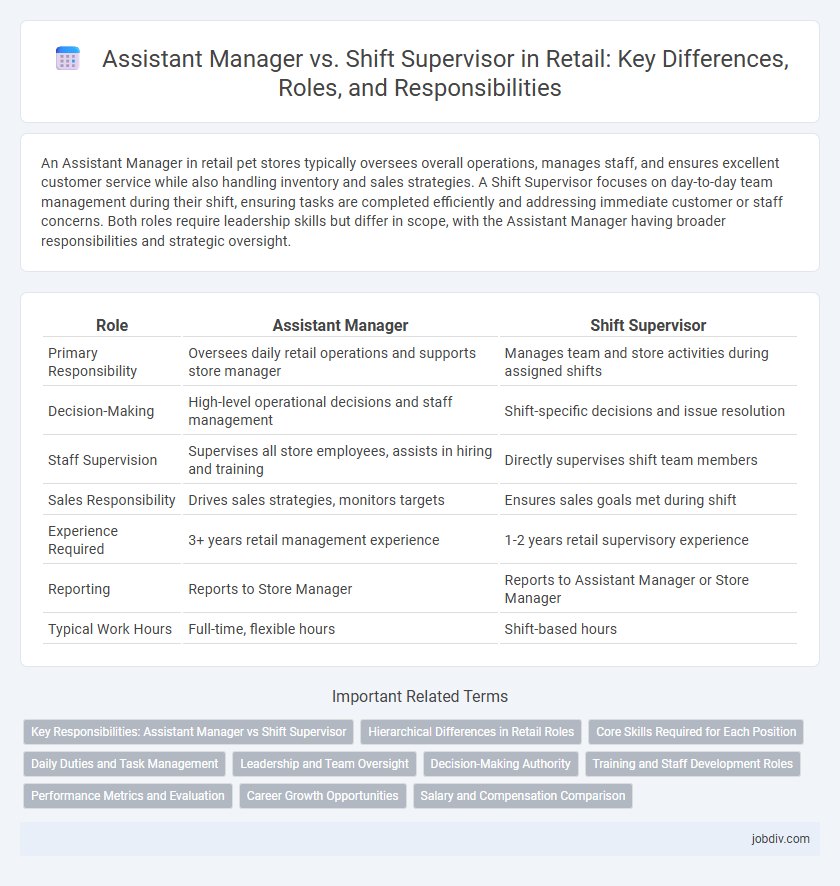An Assistant Manager in retail pet stores typically oversees overall operations, manages staff, and ensures excellent customer service while also handling inventory and sales strategies. A Shift Supervisor focuses on day-to-day team management during their shift, ensuring tasks are completed efficiently and addressing immediate customer or staff concerns. Both roles require leadership skills but differ in scope, with the Assistant Manager having broader responsibilities and strategic oversight.
Table of Comparison
| Role | Assistant Manager | Shift Supervisor |
|---|---|---|
| Primary Responsibility | Oversees daily retail operations and supports store manager | Manages team and store activities during assigned shifts |
| Decision-Making | High-level operational decisions and staff management | Shift-specific decisions and issue resolution |
| Staff Supervision | Supervises all store employees, assists in hiring and training | Directly supervises shift team members |
| Sales Responsibility | Drives sales strategies, monitors targets | Ensures sales goals met during shift |
| Experience Required | 3+ years retail management experience | 1-2 years retail supervisory experience |
| Reporting | Reports to Store Manager | Reports to Assistant Manager or Store Manager |
| Typical Work Hours | Full-time, flexible hours | Shift-based hours |
Key Responsibilities: Assistant Manager vs Shift Supervisor
Assistant Managers in retail oversee daily store operations, manage staff performance, and implement sales strategies to drive revenue growth, while Shift Supervisors focus on supervising frontline employees during shifts, ensuring customer service standards, and handling immediate operational issues. Assistant Managers often participate in budget management, inventory control, and staff training initiatives, whereas Shift Supervisors prioritize shift scheduling, task delegation, and resolving on-the-floor conflicts. Both roles contribute to smooth store functioning, but Assistant Managers have broader managerial duties and strategic responsibilities compared to the more executional role of Shift Supervisors.
Hierarchical Differences in Retail Roles
In retail, the Assistant Manager typically holds a higher hierarchical position than the Shift Supervisor, overseeing multiple shifts and operations while supporting the Store Manager. Shift Supervisors manage day-to-day activities on the floor during their assigned shifts, focusing on direct staff supervision and customer service. The Assistant Manager participates in strategic decision-making, inventory management, and performance evaluations, whereas the Shift Supervisor ensures operational efficiency within their shift parameters.
Core Skills Required for Each Position
Assistant Managers in retail require strong leadership abilities, proficiency in inventory management, and advanced problem-solving skills to oversee store operations effectively. Shift Supervisors need excellent communication skills, customer service expertise, and the capacity to manage team dynamics during shifts. Both roles demand adaptability and decision-making skills, but Assistant Managers focus more on strategic planning while Shift Supervisors emphasize real-time operational oversight.
Daily Duties and Task Management
Assistant Managers in retail oversee overall store operations, including inventory management, sales tracking, and team performance evaluations, ensuring targets are met consistently. Shift Supervisors manage daily employee schedules, monitor customer service quality, and handle immediate store issues during their shifts to maintain smooth workflow. Both roles require effective communication and leadership skills, but Assistant Managers typically engage in broader strategic planning, while Shift Supervisors focus on real-time task coordination and staff supervision.
Leadership and Team Oversight
Assistant Managers in retail oversee broader operational leadership, managing multiple departments, driving sales strategies, and ensuring compliance with company policies, while Shift Supervisors focus on direct team oversight during their shifts, handling immediate employee performance and customer service issues. Leadership responsibilities for Assistant Managers include training staff, resolving escalated conflicts, and analyzing sales metrics to improve store performance, whereas Shift Supervisors coordinate daily tasks, monitor attendance, and maintain workflow efficiency. Both roles require strong communication and problem-solving skills, but Assistant Managers hold more strategic authority and longer-term accountability compared to the operational and shift-specific focus of Shift Supervisors.
Decision-Making Authority
Assistant Managers in retail generally hold broader decision-making authority, overseeing multiple shifts and implementing store policies, while Shift Supervisors primarily make real-time operational decisions during their specific shifts. The Assistant Manager's role includes staffing decisions, conflict resolution, and strategic planning, whereas Shift Supervisors focus on managing employees and customer issues on the floor. This division ensures that Assistant Managers handle higher-level responsibilities, while Shift Supervisors address immediate, shift-specific challenges.
Training and Staff Development Roles
Assistant Managers in retail typically oversee comprehensive staff training programs, ensuring team members develop advanced customer service and operational skills. Shift Supervisors focus on real-time coaching and performance monitoring during shifts, directly addressing training needs and reinforcing company standards. Both roles are crucial for staff development, with Assistant Managers shaping long-term growth strategies and Shift Supervisors managing immediate skill application.
Performance Metrics and Evaluation
Assistant Managers in retail are evaluated using comprehensive performance metrics such as sales growth, employee productivity, and customer satisfaction scores. Shift Supervisors are primarily assessed based on real-time operational efficiency, staff adherence to protocols, and immediate issue resolution during shifts. Performance evaluations for Assistant Managers emphasize strategic contributions and team leadership, while Shift Supervisors focus on tactical execution and day-to-day management effectiveness.
Career Growth Opportunities
Assistant Managers in retail often have broader responsibilities including strategic planning and team leadership, positioning them for higher management roles such as Store Manager or Regional Manager. Shift Supervisors typically focus on operational tasks during their shifts, providing valuable frontline experience that can lead to promotions into assistant manager positions. Career growth opportunities for Assistant Managers tend to be faster and more diverse due to their involvement in higher-level decision making and cross-departmental coordination.
Salary and Compensation Comparison
Assistant Managers in retail typically earn a higher salary than Shift Supervisors due to greater responsibilities in staff management and operational decision-making. Average salaries for Assistant Managers range from $45,000 to $60,000 annually, whereas Shift Supervisors generally earn between $30,000 and $45,000 per year. Compensation packages for Assistant Managers often include bonuses, profit-sharing, and enhanced benefits, reflecting their elevated role compared to Shift Supervisors.
Assistant Manager vs Shift Supervisor Infographic

 jobdiv.com
jobdiv.com